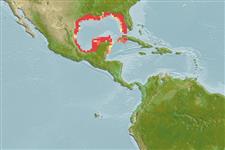Actinopterygii (ray-finned fishes) >
Tetraodontiformes (Puffers and filefishes) >
Tetraodontidae (Puffers) > Tetraodontinae
Etymology: Sphoeroides: Greek, sphaira = ball + Greek, suffix, oides = similar to (Ref. 45335).
Environment / Climate / Range
Ecology
Marine; brackish; demersal. Subtropical, preferred ?; 31°N - 18°N, 98°W - 82°W
Western Atlantic: northern and western Gulf of Mexico, from northwestern Florida in USA to Campeche in Mexico.
Size / Weight / Age
Maturity: Lm ? range ? - ? cm
Max length : 15.0 cm TL male/unsexed; (Ref. 7251)
Short description
Morphology | Morphometrics
Dorsal
spines
(total): 0;
Dorsal
soft rays
(total): 8;
Anal
spines: 0;
Anal
soft rays: 7. Dorsally and laterally, basal pigmentation is a light grey or brown, with numerous spots and blotches, especially evident on lower flanks, where they form an irregular row near the ventrolateral body angle. An axil spot present, but is no more intense than other lateral spots and blotches. Ventral surface unpigmented. Prickles present from the snout to near dorsal fin, and chin to near to near anus ventrally, and present laterally on cheeks and to near level of dorsal fin. Lappets absent (Ref 53033).
Inhabits shallow, turbid coastal waters and estuaries.
Life cycle and mating behavior
Maturity | Reproduction | Spawning | Eggs | Fecundity | Larvae
Robins, C.R. and G.C. Ray, 1986. A field guide to Atlantic coast fishes of North America. Houghton Mifflin Company, Boston, U.S.A. 354 p. (Ref. 7251)
IUCN Red List Status (Ref. 115185)
CITES (Ref. 94142)
Not Evaluated
Threat to humans
Harmless
Human uses
More information
Age/SizeGrowthLength-weightLength-lengthLength-frequenciesMorphometricsMorphologyLarvaeLarval dynamicsRecruitmentAbundance
ReferencesAquacultureAquaculture profileStrainsGeneticsAllele frequenciesHeritabilityDiseasesProcessingMass conversion
Tools
Special reports
Download XML
Internet sources
